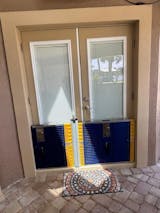Renovating your home can be an exciting adventure, but it's essential to tread carefully, especially when it comes to changes that could impact your home's flood resilience. While you may have grand visions of transforming your space, certain home renovation mistakes could potentially lead to water damage and flooding. Here are some common blunders to avoid.
Never ever do something because it is a trend. Do it because you love it
This advice holds particularly true when it comes to home renovations. While certain trends may be visually appealing or popular at the moment, it's crucial to consider the potential consequences, especially when it comes to preventing flooding and water damage. Here are some examples of trendy renovation choices that could inadvertently lead to water-related issues:
- Open Concept Floor Plans: Open concept floor plans have been all the rage in recent years, offering a spacious and airy feel to homes. However, removing walls to create an open layout can sometimes compromise the integrity of the home's structure, including its ability to withstand water infiltration during floods or heavy rains. Without proper reinforcement or support, water can flow freely throughout the space, causing extensive damage to floors, walls, and belongings.
- Installing Trendy Flooring Materials: While trendy flooring materials such as bamboo, cork, or reclaimed wood may add character to your home, they may not always be the most water-resistant options. In areas prone to moisture, such as kitchens, bathrooms, or basements, opting for flooring materials that are susceptible to warping or water damage could lead to costly repairs down the line.
- Skipping Proper Waterproofing in Wet Areas: Renovating bathrooms or basements without proper waterproofing measures is a recipe for disaster. Neglecting to install waterproof membranes, sealants, or moisture barriers can result in water seepage, mold growth, and structural damage over time. Even if a sleek, minimalist bathroom design is on-trend, it's essential to prioritize functionality and durability to prevent potential flooding issues.
- Overlooking Landscape Trends: Landscaping trends, such as installing decorative ponds, water features, or rain gardens, can add beauty and charm to your outdoor space. However, if not properly designed or maintained, these features can become sources of water-related problems. Poorly constructed ponds or rain gardens can overflow during heavy rains, leading to soil erosion, flooding, and water damage to nearby structures.
- Neglecting Gutters and Downspouts: Modern architectural trends often favor sleek, minimalist designs with clean lines and simplified exteriors. While this aesthetic may be visually appealing, it can sometimes result in the omission of essential features such as gutters and downspouts. Without proper drainage systems in place, rainwater can accumulate around the foundation of the home, increasing the risk of basement flooding and water intrusion.

Never ever sign a contract/agreement without reading it.
This wise advice applies not only to legal documents but also to contracts related to home renovations or property maintenance. Failure to thoroughly review and understand the terms of such agreements could leave homeowners vulnerable to potential flooding and water damage. Here are some examples of clauses or oversights in contracts that could lead to water-related issues:
- Lack of Waterproofing Specifications: In contracts for home renovations or construction projects, there should be clear specifications regarding waterproofing measures, especially in areas prone to water exposure such as bathrooms, basements, or exterior walls. If these details are overlooked or omitted from the contract, contractors may not prioritize proper waterproofing, leaving the home susceptible to water damage in the future.
- Inadequate Drainage Plans: Contracts for landscaping or outdoor renovation projects should include detailed plans for drainage systems to ensure that water is directed away from the home's foundation. Failure to address drainage issues in the contract could result in water pooling around the property, increasing the risk of basement flooding or structural damage.
- Unaddressed Plumbing Concerns: Contracts for plumbing work should outline the scope of the project, including any repairs or installations necessary to prevent water leaks or pipe bursts. If plumbing issues are not adequately addressed in the contract, homeowners may be left with subpar workmanship that puts their property at risk of water damage.
- Omission of Maintenance Responsibilities: Contracts for services such as gutter cleaning, sump pump maintenance, or roof inspections should clearly define the responsibilities of both the homeowner and the service provider. Without a clear understanding of who is responsible for routine maintenance tasks, critical flood prevention measures may be neglected, leading to water-related issues over time.
- Misunderstanding Insurance Coverage: Contracts for home renovation or repairs should not only outline the scope of work but also clarify any changes to insurance coverage or liability in the event of water damage. Failure to understand the insurance implications of a contract could leave homeowners financially vulnerable if flooding occurs as a result of the work performed.
- Ignoring Permit Requirements: Contracts should specify who is responsible for obtaining necessary permits for home renovation or construction projects, including those related to flood prevention measures such as retaining walls, stormwater management systems, or basement waterproofing. Failing to secure proper permits can result in costly fines or legal issues down the line, not to mention potential water damage if the work is not up to code.

Never put the kitchen sink in a corner
While this design choice may seem unconventional, there are practical reasons behind it, including the risk of potential flooding and water damage. Here are some examples of how placing the kitchen sink in a corner could lead to water-related issues:
- Limited Space for Drainage: Placing the kitchen sink in a corner can restrict the available space for drainage systems, such as pipes and plumbing fixtures. If the drainage system is not properly designed or installed, water may not flow efficiently away from the sink, leading to backups, leaks, and potential water damage to surrounding cabinets, floors, and walls.
- Proximity to Walls and Cabinets: In a corner sink configuration, the sink is often situated close to adjacent walls and cabinets. If there are any gaps or weaknesses in the seals around these structures, water from the sink can seep into the surrounding areas, causing moisture damage, mold growth, and structural issues over time.
- Accessibility Challenges: Corner sinks may be less accessible for maintenance and repairs compared to sinks placed along a wall or in the center of a countertop. Difficulties accessing plumbing connections or performing routine maintenance tasks could lead to overlooked issues that contribute to water damage over time.
- Limited Workspace: Corner sinks can also result in limited workspace around the sink area, making it more challenging to contain and clean up spills or leaks promptly. Without adequate space for drying dishes or wiping down countertops, water may accumulate and cause damage to nearby surfaces if not addressed promptly.
- Inefficient Use of Space: From a functional standpoint, corner sinks may not make the most efficient use of available kitchen space. Awkward angles and limited access to the sink can make everyday tasks such as washing dishes or preparing food more cumbersome, increasing the likelihood of spills and water-related accidents.
- Potential for Structural Damage: If water leaks from the sink go unnoticed or unaddressed for an extended period, they can lead to structural damage, including rotting wood, deteriorating cabinets, and compromised flooring. Over time, this can weaken the structural integrity of the kitchen and necessitate costly repairs.
Alright, fellow homeowners, let's have a real talk about protecting our nests. We all know that sinking feeling when disaster strikes, especially when it's flooding. But fear not, because there's a savvy solution: flood barriers.
Picture this: You've put your heart and soul into renovating your home, making it just the way you like it. Then, out of nowhere, a flood comes knocking and ruins everything. It's enough to make you want to throw in the towel, right?
That's where flood barriers step in. These babies are like the ultimate insurance policy for your home. They keep water out, so you can keep on living your best life without worrying about soggy carpets or ruined belongings.
$949.00
DAM EASY® FLOOD GATE - DOOR DAM Floods are becoming more common around the world. What was once a 100-year phenomenon is now a seasonal trend that homeowners must deal with. That’s EXACTLY why you need this Dam Easy Flood… Read MoreFlood Barrier Door Dam - Ultimate Flood Gate

Now, we get it—flood barriers might not be the most exciting addition to your home renovation plans. But trust me, when the next big storm rolls in, you'll be thanking your lucky stars for having them installed.
So, fellow homeowners, let's be smart about this. Let's make flood barriers a priority in our renovation projects. Because when it comes to protecting our homes and our peace of mind, there's no such thing as being too prepared.




















